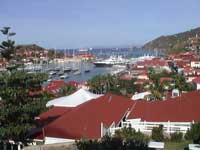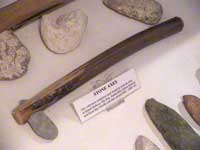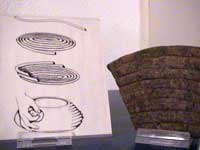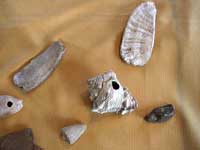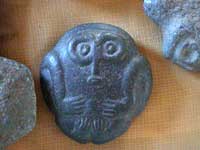
We’re back in St. Barts! The Nantucket Clipper is revisiting the islands we saw last week. But this time we’re exploring different things on each island. Today we’re visiting a local museum to learn about the Caribbean’s first settlers, people called the Taino ("Tie-ah-no"). The museum has lots of things made by the Taino (sometimes called the Arawaks). Taino people had long black hair. They decorated themselves with feathers, beads, and tattoos. About 2,500 years ago, these people traveled in small groups up the islands of the Caribbean from the northern shores of South America. The Taino traveled in canoes made of hollowed-out logs. Each canoe held 50 people. Half the people would row while the others rested. The Taino were gentle, peaceful people who planted, hunted and fished. They planted maize, sweet potatoes, vegetables, fruits and tobacco. They hunted docks, doves, parrots and iguana. They caught fish using traps made from woven tree bark. They also harvested conchs (see December 20, 2000 journal), crabs, lobsters and sea urchins. The Taino were excellent carvers, weavers, potters and basket makers. They used stones and pieces of wood and shells as tools. Conch-shell tools were used in boat building. After a tree was cut down, they burned the trunk. Then, using their conch-shell tools, they scraped away the charred wood. This was repeated until the boat was in the shape they wanted. The Taino also wove with the long grasses that grew wild on the island. The Taino did not have pottery wheels for shaping pots. To make their pottery, the Taino rolled clay into long thin ropes. Then they coiled the ropes of clay around and around in a circle. The clay ropes became the bottoms, sides and tops of their pottery, which they dried to harden. The Taino believed that gods controlled rain, wind, hurricanes and fire. They carved small rocks or pieces of wood into shapes of animals or people and worshipped them. The Taino believed that after death, they went to a place where no hurricanes or sickness existed and where they would eat and dance all day long. Unfortunately, the Taino people were killed by fierce warriors, called the Caribs ("care-eebs"). The Caribs also moved up into the Caribbean from South America in their canoes. But their big canoes could hold as many as one hundred warriors! The Caribs were expert hunters and warriors, who were skilled with bows and arrows. When Columbus reached islands in the Caribbean, the people he met were mostly Caribs. So even though the Taino were the first to settle in the Caribbean, we call these the Caribbean Islands – named after the people who killed off the original settlers of these islands. Today the Caribs are gone as well. Not only did they lose wars with European settlers, they died from the many European diseases that were introduced to the region. The Caribs did not have immunity to these illnesses. Now, all that remains of these early Caribbean settlers are the museum objects we’re viewing today. |
The Nantucket Clipper is anchored in St. Barts, just outside the Gustavia harbor. In the distance is the island of Anguilla.
The Taino used rocks, wood and shells as tools. This stone ax is made from a rock and a tree branch.
A broken piece of pottery shows how the Taino made vessels from long rope-like strips of clay. The Taino wound the clay ropes together to form their pots.
Taino people ate conches for food and used pieces of the shells for tools. They also cut holes in conch shells and blew them like trumpets!
This small rock, which is about half the size of your fist, looks like a Pokemon character! The Taino carved rocks like this to use in their religious ceremonies. |
|||||||||||||||||||||
|
||||||
